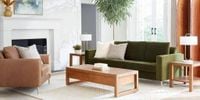As the world of interior design continues to evolve, 2025 is set to bring a refreshing wave of trends that reflect a shift towards more personal and sustainable aesthetics. According to Forma Furniture, a leading furniture retailer based in Colorado, homeowners are increasingly prioritizing beauty, functionality, and a connection to nature in their living spaces.
One of the most significant changes in the design landscape is the official farewell to gray tones. For over a decade, shades of gray have dominated the interior design scene, but as of 2025, their grip has loosened. Designers are moving away from this once-popular palette, signaling a desire for warmer and more inviting colors.
In addition to gray tones, other trends are also fading into the background. Barn doors and shiplap, once staples in modern farmhouse aesthetics, are being replaced or reimagined. While barn doors were appreciated for their space-saving qualities, designers are now seeking alternatives that better align with contemporary tastes. Similarly, shiplap, characterized by its horizontal planks, has seemingly worn out its welcome, making way for fresher looks.
Minimalism, which had its moment in the spotlight, is also losing its appeal. While some still find solace in its simplicity, the trend is no longer captivating designers and homeowners in the same way it once did. Instead, the modern farmhouse aesthetic is evolving rather than disappearing, with many designers infusing it with an industrial edge.
Another notable shift is the growing rejection of cheap and disposable furniture. Homeowners are increasingly opting for high-quality, sustainable pieces that stand the test of time. This trend reflects a broader awareness of environmental issues, as consumers seek to minimize waste and invest in furniture that is not only stylish but also durable.
So, what’s in for interior design in 2025? One of the most exciting trends is color drenching, a bold approach where a room is painted entirely in one color, including walls, ceilings, doors, and trim. This technique creates a sense of cohesion and can make spaces feel larger by eliminating visual boundaries. Whether opting for light, calming hues or deep, rich tones, color drenching is a way to express individuality and create a unique atmosphere.
Earth tones are making a comeback as well, offering a warm and welcoming alternative to the cool grays of the past. Shades of brown, muted greens, rust, terracotta, and creamy beiges are becoming increasingly popular, as they evoke a sense of comfort and connection to nature. This trend aligns with the biophilic design movement, which emphasizes the integration of natural elements into modern decor.
Handcrafted art and decor items are also in high demand this year. There’s a noticeable shift away from mass-produced pieces, with consumers seeking organic, unfinished looks created by artisans. This desire for unique, handmade items reflects a broader trend towards personal expression in home decor.
High-quality, sustainable furniture is not just a trend but a movement. As consumers become more discerning, they are looking for pieces that are not only aesthetically pleasing but also environmentally responsible. Companies like Copeland, known for their commitment to sustainability and quality, are leading the charge in this area.
Beyond these primary trends, several other interesting design elements are gaining traction in 2025. Clay and ceramic tiles are making a resurgence, providing a versatile and stylish option for both floors and walls. Lighting that doubles as an artistic statement is also becoming increasingly popular, allowing homeowners to express their style while illuminating their spaces.
Moreover, personal expression is at the forefront of design, with spaces being tailored to reflect individual lifestyles and preferences. Curved forms in furniture and cabinetry are gaining popularity, softening the overall aesthetic and creating a more inviting atmosphere. Metals with patina are also in vogue, adding a touch of character and history to modern designs.
Wellness-inspired designs are becoming essential as well, with many homeowners seeking to create in-home sanctuaries that promote relaxation and well-being. Drapery is being reimagined as an art form, with bold patterns and textures taking center stage. Additionally, mixing different woods and metals is a trend that allows for a more eclectic and personalized look.
Neutrals with pops of color are another exciting development, offering a way to add vibrancy to otherwise subdued palettes. Designers are also experimenting with multiple shades of green, further promoting a connection to nature. Wallpaper is making a comeback, with creative applications including ceilings, which can transform a room dramatically.
As we look to the future of interior design, it’s clear that trends in 2025 are about more than just aesthetics; they reflect a deeper understanding of sustainability, personal expression, and the importance of creating spaces that resonate with our lifestyles. Forma Furniture encourages homeowners to explore these trends and consider how they might update their living spaces to reflect their unique tastes and values.
For those interested in exploring these trends further, Forma Furniture has locations in Fort Collins, Boulder, and Northglenn, where customers can experience top-quality pieces from respected, sustainability-focused designers. The team at Forma Furniture is ready to assist with any questions and provide guidance on how to achieve the desired look for your home.
As we embrace these new trends, the world of interior design continues to inspire creativity and innovation, making it an exciting time to refresh our living spaces.

